|
Senior Bowl
by "Bondo" Phil Brandt
|
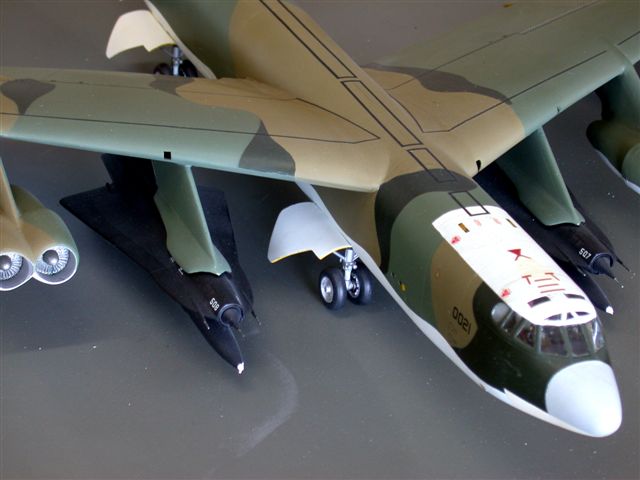 |
|
B-52H with Senior Bowl |

HyperScale is proudly supported by
Squadron.com
Representing perhaps the darkest of the CIA 'Black Programs' in
the late Sixties and early Seventies, Senior Bowl used two modified
B-52Hs as airborne launch platforms for Mach 3+ Lockheed D-21B
reconnaissance drones. The loss of a Lockheed M-12 Blackbird mother
ship and one aircrew member in a mid-air with its just-released
drone sounded the death knell for the earlier Tagboard program.
After release, a large Lockheed solid fuel booster accelerated
the Marquardt ramjet-powered drone to its Mach 3.35 operational
speed. Four launches of highly classified operational missions
targeting mainland China (most likely the Lop Nor nuclear test site)
occurred probably between the Hawaiian Islands and Midway Island.
The D-21B drone operated at approximately 90,000 feet altitude, and
its route and sensor operation was controlled by an on-board
Honeywell automatic navigation system. Upon return to mid-Pacific,
the sensor package was jettisoned for airborne pickup by a JC-130,
and the drone was command-destructed by the B-52 launch ship.
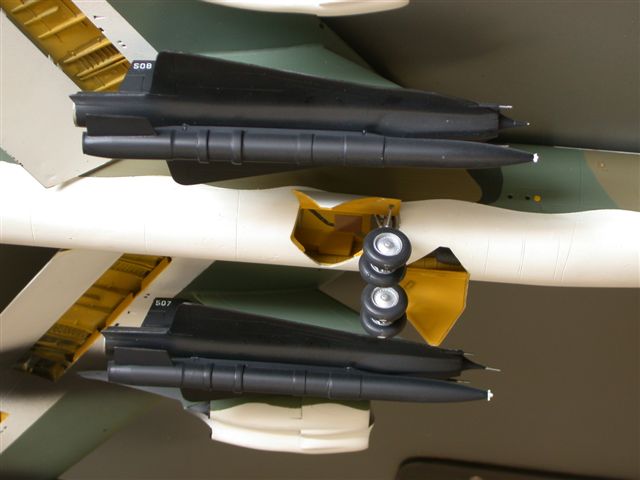
The D-21B never returned from its first operational mission on 9
November 1969. It may have flown on past its Chinese target, into
the Soviet Union, because years later Skunk Works famed boss, Kelly
Johnson, while touring Russia was presented with a smashed fragment
of an airframe which turned out to be from the missing drone!
The 16 December 1970 second mission went as planned, but the
sensor package was not recovered. The third mission, on 4 March
1971, also returned to the recovery point, but the sensor package
sank as the Navy attempted a recovery. The fourth, and final,
mission was launched on 20 March 1971; the drone never returned and
was assumed to have been destroyed by exceptionally heavy air
defenses over the target area.
The international Peacetime Aerial Reconnaissance Program (PARPRO)
Treaty negotiated in 1971 and lingering CIA reservations toward the
drone program spelled an end to the operational career of the exotic
drone, and the surviving airframes were moved to longterm,
semi-secure, outdoor storage at Davis Monthan Air Force Base. Since
the breakup of the Soviet Union, most of the surviving D-21B
airframes out of the thirty-eight originally manufactured were given
to museums; four remain with NASA for various high speed test
programs. Today, at the USAF Museum in Dayton, Ohio, or at Tucson's
Pima County Air and Space Museum, you can get right up close to the
Darth Vader-ish black shape that not so long ago was one of this
country's most closely held secrets.
This model portrays B-52H 61-0021 loaded with D-21B articles 508
and 509 prior to the first Senior Bowl two-drone test flight on 28
November 1967. Photographs taken at that time show that the standard
SIOP paint scheme was very clean because the aircraft has just come
out of Lockheed "Skunkwork's" modification facilities.
B-52H Construction
Although the only injected 1/72 H model extant, and engraved at
that, deficiencies of the AMT/Ertl B-52H have been well documented
on this and other modeling websites: a) wings are in more of a
flight configuration than static, that is, the familiar, pronounced
droop of fueled B-52 wings at rest is missing and b) the engine pods
are significantly undersize. I planned a major kitbash to solve
both.
One of my elderly Monogram B-52Ds furnished the wings (rescribed),
and the wing saddle section from the upper center of the fuselage
was cut out and grafted onto the Ertl fuselage to define the proper
wing anhedral and mate exactly with the 'new' wings. Added bonuses
were deployable flaps and spoilers. And yes, Bondo's aware that late
BUFF spoilers are shaped differently; I'm invoking the "close enough
for government work" rule on this one!
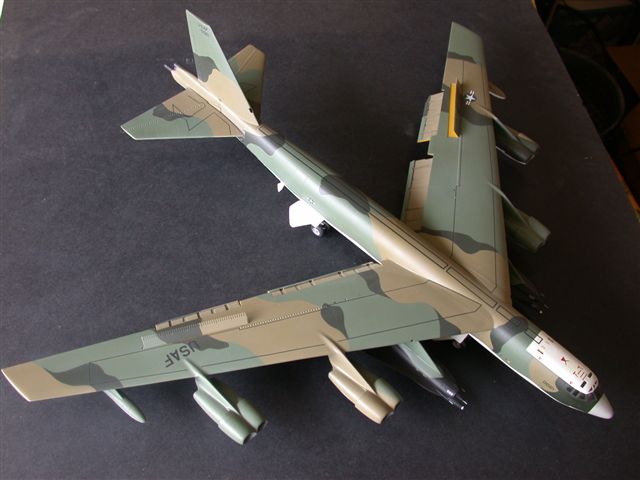
The undersized engine pods were replaced by a corrected resin set
done by Red Dog Resins (now out of production). Plan B would be to
find ones done long ago by defunct DB Productions in the U.K. I
don't know if Flightpath has acquired these parts. The engine mods
are not a turnkey job because the aft sections had to be widened
slightly with plastic strip, and fan bypass vanes had to be
scratchbuilt. Additionally, the Ertl H engine pylons had to be
grafted onto the Monogram wings and also to the pods. Putty City!
The large Monogram D model iron bomb pylons fit right in to the
wings, but the lower drone mating 'shrouds' were scratchbuilt as per
Skunk Works pix of the real thing. Also, the pylon trailing edges
had to be reprofiled to match the leading edge of the GT-21B's
vertical fin.
GT-21B Drones
The rescribed drones were 'cannonballed' from Monogram SR-71 kits.
The distinct curvature of the jettisonable sensor pallets under and
just aft of the nose aren't well represented, so they were enhanced
with A&B epoxy putty.
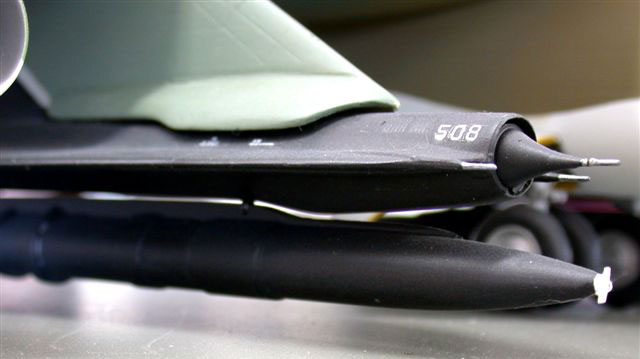
The gently tapering nose sections of the huge rocket boosters
were created from ballpoint pen sections, with the aft booster
sections represented by plastic tube. Larger diameter ring sections
of tube were cut and slipped over the assembly to create the "bumps"
as per the 1:1 version. The small white ram air turbine (RAT) in
each nose was scratchbuilt, as was the folding ventral fin on the
booster's aft section.
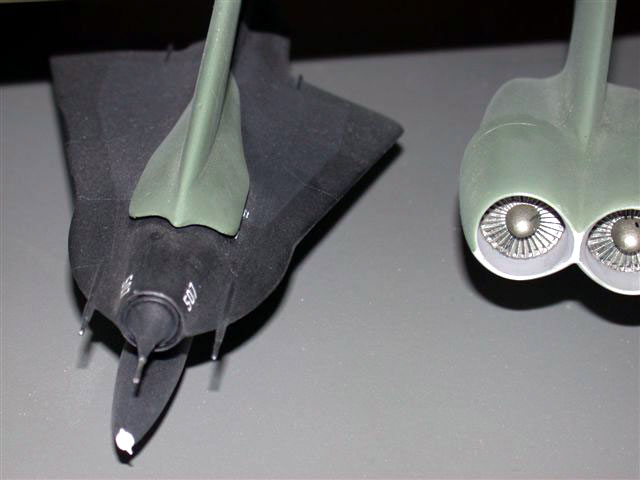
Don't
believe I'd a tol' that... |
I entered this combo in the San Antonio ModelFiesta three years
ago, and an ex-BUFF guy came up to me asking what, if anything, I
thought was wrong with my entry. I checked over the rig and couldn't
come up with anything big. He smiled and directed my gaze toward the
20mm "stinger" and tracking radome at the tip of the empennage.
It seems I had assembled that portion of the sizeable airframe
with the almost completed bird upside down on a pillow. Although
Bondo's been looking at BUFFs for over thirty-five years, and since
the fuselage cross section at that point was almost symmetrical,
with the thing upside down I had reversed the single piece
containing both gun and radome, putting the radome on ze bottom!
Lotsa laughs, and I got to saw off the offending section, reglue
and repaint the following week.
Phil Brandt
IPMS 14091
Click the thumbnails
below to view larger images:
Review and Images Copyright © 2002 by
Phil Brandt
Page
Created 06 May, 2002
Last updated
04 June, 2007
Back to HyperScale Main
Page
Back to Reviews
Page
|
Home
| What's New |
Features |
Gallery |
Reviews |
Reference |
Forum |
Search